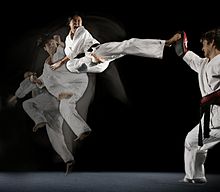The term martial arts refers to the art of warfare (derived from Mars/Ares the Greek god of war) and comes from a 15th-century European term referring to what are now known as historical European martial arts specifically to what is today known as Historical Fencing, but is now most commonly associated with Asian fighting styles, especially the combat systems that originated in East Asia. The term both in its literal meaning however, and in its subsequent usage may be taken to refer to any codified combat system, regardless of origin, a practitioner of martial arts is referred to as a martial artist. Martial arts have originated and evolved in various cultures at various times. In the Americas, Native Americans have traditions of open-handed martial arts such as wrestling, while Hawaiians have historically practiced arts featuring small and large-joint manipulation. A mix of origins is found in the athletic movements of Capoeira, which African slaves developed in Brazil based on skills they had brought from Africa.
Martial arts vary widely, and may focus on a specific area or combination of areas, but they can be broadly grouped into focusing on strikes, grappling, or weapons training. Below is a list of examples that make extensive use of one of these areas; it is not an exhaustive list of all arts covering the area, nor are these necessarily the only areas covered by the art but are the focus or best known part as examples of the area:
Strikes
- Punching: Boxing (Western), Wing Chun,
- Kicking: Capoeira, Savate, Taekwondo
- Other strikes: Karate, Muay Thai, Kung Fu
- Throwing: Glima, Jujutsu, Sambo, Judo
- Joint lock/Submission holds: Aikido, Brazilian Jiu-Jitsu, Hapkido, Judo
- Pinning Techniques: Wrestling, Judo
Weaponry
- Traditional Weaponry: Eskrima, Fencing, Gatka, Kendo, Kyūdō
- Modern Weaponry: Jukendo
Testing and competition
Testing or evaluation is important to martial art practitioners of many disciplines who wish to determine their progression or own level of skill in specific contexts. Students within individual martial art systems often undergo periodic testing and grading by their own teacher in order to advance to a higher level of recognized achievement, such as a different belt color or title. The type of testing used varies from system to system but may include forms or sparring.Various forms and sparring are commonly used in martial art exhibitions and tournaments. Some competitions pit practitioners of different disciplines against each other using a common set of rules, these are referred to as mixed martial arts competitions. Rules for sparring vary between art and organization but can generally be divided into light-contact, medium-contact, and full-contact variants, reflecting the amount of force that should be used on an opponent.

No comments:
Post a Comment